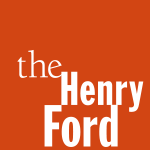Henry Ford Museum/Greenfield Village History
- The museum and village originally began as the collection of its namesake founder, Henry Ford.
- Together the Henry Ford Museum and Greenfield Village is the largest indoor-outdoor museum complex in the United States. Both opened to the public in 1933.
- The Henry Ford Museum features a collection of historic artifacts important to American innovation and history.
- Greenfield Village is the outdoor living history museum section of the Henry Ford complex. The village features numerous historical buildings (moved in from various places) and is almost a recreation of historic early 1900's America.
- Greenfield Village features the 2 mile "Weiser Railroad" which loops the property and is powered exclusively by steam locomotives.
- https://www.thehenryford.org/
Weiser Railroad History
- Originally a simple straight stretch of track along the northern edge of the museum, which was dedicated in 1929.
- The railroad has since expanded to a two mile loop around the village, and has four stations.
- The "Railroad Juncton" station is the former GTR Smiths Creek depot, which was relocated to the property.
- The four stations are: "Firestone," "Susquehanna," "Walnut Grove" (used for special events only), and "Railroad Junction."
- Locomotives are operated for 30 days and then switched out.
- Locomotives are restored and repaired in a replica roundhouse which was based on the Detroit, Toledo & Milwaukee Railroad roundhouse in Marshall, Michigan. (Pieces of the former roundhouse were used in construction of the replica). The replica roundhouse was opened to the public in 2000.
- The turntable came from Petoskey, Michigan. It was built in 1901 for the Pere Marquette Railroad and has no motor (turned by hand).
- After the roundhouse was completed, the former engine shed was re-purposed as a garage for the Village's many vehicles.
- The railroad has a direct connection to the national railway network, via the Amtrak/MDOT Michigan Line. The railroad once received hoppers of coal from Norfolk Southern. Coal for the steam locomotives is now trucked into the Village.
Greenfield Village/Weiser Railroad Locomotives
|
|
| Number
|
Model
|
Year(s) Built
|
History
|
Notes
|
| "Edison" #1
|
4-4-0
|
1875 (1932)
|
Originally built as an 0-4-0 for Edison Portland Cement by Manchester Locomotive Works. Rebuilt into a 4-4-0 by Ford in 1932.
|
Main locomotive. In active service.
|
| Naval Ammunitions Depot Charleston #1
|
45-Ton
|
1942
|
Built by GE for the Naval Ammunitions Depot of Charleston, SC. Ex-USN 65-00002.
|
Used as a switcher and backup power for the steam locomotives.
|
| Hecla & Torch Lake #3 "Torch Lake"
|
0-6-4T
|
1873
|
Built by Mason Machine Works. Donated to Henry Ford in 1969. Known as a "Mason Bogie" locomotive.
|
Main locomotive. In active service. Oldest regularly operating steam locomotive in the US.
|
| Detroit & Lima Northern #7
|
4-4-0
|
1897
|
Built by Baldwin. Donated to Henry Ford in 1930.
|
Main locomotive. In active service.
|
| Detroit & Mackinac #8
|
0-6-0
|
1914
|
Originally built for Michigan Alkali by Baldwin. Donated by D&M to Henry Ford in 1979.
|
In storage. May possibly be restored to operation in the near future.
|
|
Greenfield Village/Weiser Railroad Rolling Stock
|
|
| Number
|
Model
|
Year(s) Built
|
Notes
|
| CNSM 761
|
Interurban
|
1930
|
Traded to the East Troy Railway Museum in 2001 for South Shore #11.
|
| USAF C-258
|
Crane
|
19??
|
Scrapped in 2011.
|
|
Henry Ford Museum Locomotives
|
|
| Number
|
Model
|
Year(s) Built
|
Notes
|
| CNSM 761
|
Interurban
|
1930
|
Traded to the East Troy Railway Museum in 2001 for South Shore #11.
|
| USAF C-258
|
Crane
|
19??
|
Scrapped in 2011.
|
|
Henry Ford Museum Rolling Stock
|
|
| Number
|
Model
|
Year(s) Built
|
Notes
|
| CNSM 761
|
Interurban
|
1930
|
Traded to the East Troy Railway Museum in 2001 for South Shore #11.
|
| USAF C-258
|
Crane
|
19??
|
Scrapped in 2011.
|
|
Back to Michigan Shortlines
Back to Shortlines

